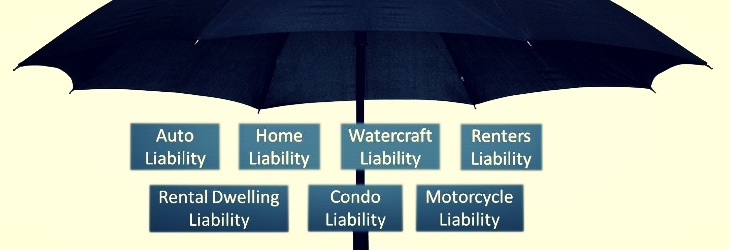The first concept to understand is that Umbrella Insurance is a liability policy, which means its primary purpose is to compensate others for “injuries” or “damages” for which the insured (you) are at fault. It’s not extra insurance for your house, cars or rental properties.
And secondly, Umbrella Insurance isn’t much use on its own. While there are certain types of claims that are only covered by an umbrella policy, most often, Umbrella Insurance ‘kicks in’ once other liability policies you have (think auto policy, homeowners, rental dwelling, watercraft, motorcycle, etc.) have been completely used up.
Umbrella insurance actually “sits” on top of your auto and homeowners or renters liability coverage. Say you have a per-person liability limit of $250,000 on your auto policy. Let’s also assume that you cause an accident in which a driver or passenger in the other car is ultimately awarded $550,000.
Your auto policy will pay the first $250,000, and your umbrella will kick in the remaining $300,000. Well, almost $300,000. Like auto policies, some umbrella policies have deductibles, usually anywhere from $250 to $2,500. But a deductible of even $2,500 is a small price to pay if you’re hit with a $550,000 judgment.
What are the requirements?
Because umbrella insurance is over the top of auto, homeowners, renters, watercraft, and other liability policies, some insurers offering umbrella policies require you to have your auto and homeowners with these companies as well. But that’s not really a problem because most insurers are thrilled to be providing someone’s auto, homeowners or renters, watercraft, rental dwelling, and umbrella insurance.
In addition, most insurers offering umbrella coverage require you to have liability limits of a certain amount on your auto and homeowners policies. Typically, this minimum is $500,000 for homeowners and $250,000 per-person for auto.
Yes, you could choose to increase your auto and homeowners liability limits to, say, $1 million for each policy. But not every auto and homeowners insurer offers such high limits.
Tip. Your umbrella policy is usually a more cost effective option than increasing the limits on your auto and homeowners insurance. Plus, you get the additional “personal injury” coverage that is not available in your auto and homeowners or renters policies.
What’s covered?
While most umbrella policies are issued with the intention of providing extra liability protection in the event your other liability policies (auto, home, rental dwelling, watercraft, etc.) are inadequate because of a serious claim, sometimes additional coverage is provided.
Typically, in order for a claim to be covered by the umbrella policy, the underlying policy for which the umbrella policy is providing the extra layer of protection must be exhausted first.
Let’s go back to our auto claim example. If you were to cause an auto accident where someone was injured in the amount of $550,000, your umbrella policy might not actually ‘kick in’ until the required underlying amount of insurance has been exhausted. Let’s assume in this example, that amount is $250,000.
So what’s the big deal?
Well, nothing: as long as your auto insurance has a limit of $250,000.
But what happens if you only have $100,000 of coverage? Or worse, you forgot to pay your auto insurance premium and your policy cancelled?
The good news is, your umbrella policy would likely still respond. The bad news is, you’re still responsible for the first $250,000 before your umbrella coverage kicks in.
Are other types of claims covered?
There are a few types of claims covered by a handful of umbrella policies, for which there’s no requirement of underlying coverage. It’s important to note, not all insurance companies provide this coverage on their umbrella policies, but that’s why it’s critical that you understand the policy you’re purchasing.
Here’s what could be included in your umbrella policy:
- False arrest
- Libel
- Slander
- Invasion of privacy
How can I get Umbrella Insurance?
It may sound strange, but you need to start with your other liability policies (auto, home, rental dwelling, watercraft, etc.) first. Work to see if these policies can be insured with the same insurance company.
From there, adding an umbrella policy is as simple (and usually, very cost effective – often less than $200 per year for $1,000,000 of coverage) as asking your insurance company to add this extra layer of coverage to your insurance program.
While adding the umbrella policy is fairly straightforward, the background work necessary to ensure you’re eligible to include this policy can be time consuming and at times, very complex. This is where it’s incredibly helpful to work with an insurance advisor experienced with Umbrella Insurance.
If you’d like to learn more, contact one of our Licensed Advisors . We’re here to help.
